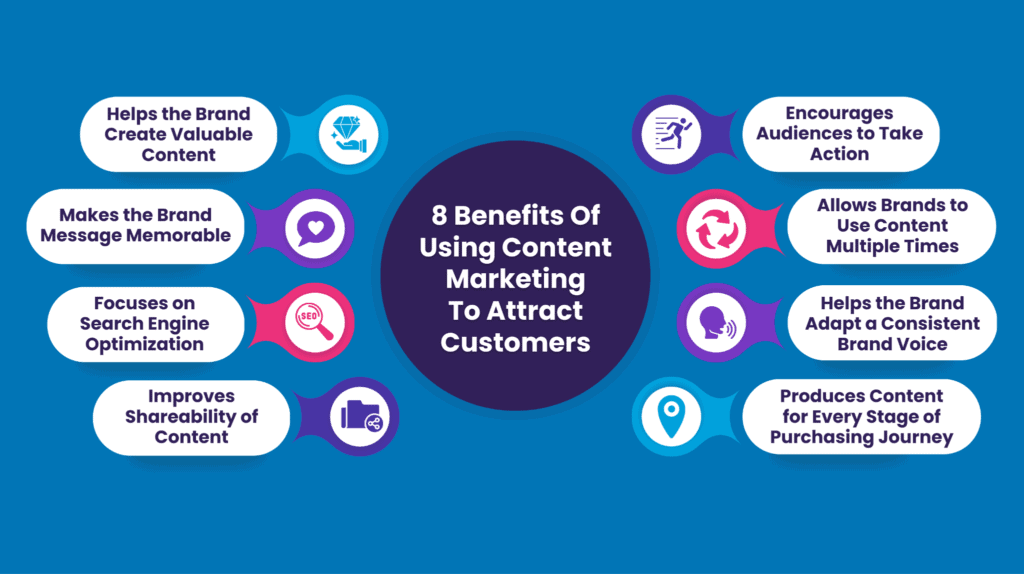Menu

Leading brands might make content marketing sound fancy and exclusive, especially for companies that are still new. But the reality is that this marketing tactic isn’t a new approach to promoting a brand – and it doesn’t need a well-trained specialist for businesses to understand how it works.
Content marketing has always been around – from magazines and newspapers to online blogs and social media posts. It helps millions of companies from different industries gain organic traffic and increase sales. And it can definitely do the same for your brand if you start publishing content in the right way, starting now.
Different sources have different explanations, but the simplest content marketing definition for businesses is that it’s a marketing approach that uses different types of content to attract, engage, and retain existing and potential customers. Good content stays at the top of a reader’s head when it’s time to buy what the brand sells.
Content marketing gives brands a competitive advantage, which is why it’s a go-to tactic with a high satisfaction rate. Here’s what a piece of content from Demand Metric has to say when it comes to the effectiveness of content marketing:
Every business needs marketing to help them reach potential customers and promote its products or services. There are many marketing forms that businesses can use, but putting content at the center stage is becoming more common for many reasons.
A lot of businesses that don’t use content marketing as part of their overall strategic marketing approach might not be aware of the many benefits it brings. If you’re still on the fence about using content and digital marketing, here are some of its advantages that may convince you to start investing in content creation:

There are many ways to increase website traffic, but these numbers alone aren’t enough to help reach business success. The brand needs qualified website traffic – the clicks from prospective customers who are likely to take action and become loyal to the brand. This is where the right content marketing strategy comes in.
A brand’s content marketing efforts usually require a meticulous study of the target audience, allowing content marketers to know what blog posts they want to read about and what various channels they’re active in. With this kind of information, brands can start creating content that’s valuable and informative to their target market.
When a brand publishes relevant content, many potential customers visit the website because it might have the information about a product or service they need. High-quality content is also good for SEO because it makes the brand more visible and accessible to the target audience.
It’s one thing to publish content that reaches new customers, but it’s another to make it memorable enough that audiences think of a specific brand immediately whenever they need the product or service it offers. Compelling content is crucial in this case because customers tend to remember brands that they see as valuable and relatable.
The best content marketing examples from leading brands are those that stick to the minds of audiences – like Spotify Wrapped, Apple’s Shot on an iPhone, and Wordle by The New York Times. These pieces of content were trending for some time because they effectively deliver the brand message of companies while piquing the interest of audiences.
A carefully planned content marketing strategy allows companies to come up with relevant content that gives value to audiences and makes them remember the brand better. Businesses can do it with an informative blog post or a social media campaign, but the catch is that they must know their audiences well first.
One essential element that sets content marketing strategy from other forms of marketing is its focus on search engine optimization (SEO) – the process of developing a website to meet certain criteria set by search engines. Doing this allows more people to find the brand or its site when they search for specific keywords.
Search engine optimization (SEO) is vital to any business because making the site more visible leads to increased traffic, which in turn attracts more opportunities to convert site visitors into loyal customers. Search engines like Google help people find high-quality content that’s relevant to their queries so their criteria are always changing to improve user experience.
Part of creating a good content marketing strategy is analyzing relevant keywords and incorporating them into the content published by the brand. Once the content is optimized, it’s highly likely for it to rank well in search engines and for audiences to find the brand’s official site quickly.
The shareability of content is also important when it comes to attracting new customers. Social currency is what makes a piece of content shareable to others, so it’s important to create content that is relatable and valuable to casual readers or existing customers.
Think of all the social media posts that a brand publishes and how the target market interacts with them. They often feature what audiences care about, discuss certain trending topics, or contribute to the brand’s credibility and authority. Content marketing strategies allow brands to come up with certain blog posts, infographics, and other types of content that get the most shares.
If you’re still predicting the preferences of audiences and how they react to different pieces of content, then you can start by learning about how leading brands from the same industry write their content. Most of them create blogs and other pieces of content that:
But the tricky part when it comes to creating shareable content is that brands might come off as “salesy” to audiences. Having a good content marketing strategy prevents this because its goal is to create pieces of content that are relatable and valuable to audiences, making them feel the need to share the content with their families and friends who also need to hear about the brand.
Call-to-action is essential to digital marketing because it’s the last push that potential customers need to purchase a product or enlist the service of a brand. High-quality content produced through careful content marketing planning can drive profitable customer action – or at least encourage them to take other important and beneficial actions like sharing the content.
If it makes sense in the article, make sure to add a call-to-action section at the end of the content to encourage readers to buy from the brand. But remember to be careful when doing this – some brands make the mistake of focusing on the call-to-action part that they end up creating content that’s purely promotional.
For the call-to-action section to be effective, brands have to provide quality content first. If the blog posts sound overly promotional, people might eventually tune out and leave the website before they get to the end. Make sure to reserve all sales copies and pieces of content on promotions and sales pages.
Creating your own content every time requires a lot of effort, time, and resources. Although relatable and informational content is crucial for many brands, it’s not practical for them to make high-performing content once but never use it again.
What’s great about content marketing is that it allows brands to make good content that they can continuously promote and share now and then across different platforms. Repurposing existing content is a clever way to get the most out of the original piece, so your content team doesn’t experience quick burnout trying to come up with new ideas every day.
For content repurposing to fit into the content marketing strategy and bring quality leads for the brand, always make sure to slightly modify and adapt each of them to suit different mediums and platforms. Here are some of the most creative ways to repurpose and use the same content multiple times:
Branding is important for businesses because it’s what people remember them by. It also allows consumers to know what to expect from the company. A trusted brand can attract its own customers even with little promotion or marketing efforts – it’s the reason why people buy iPhones from Apple instead of other smartphone brands or why customers order drinks from Starbucks instead of other coffee shops.
For a business to be recognized as a leading brand, it needs consistent content that delivers the brand message every time. Content marketing is about storytelling so brands can educate their customers, help them with their problems, and offer entertainment to them when appropriate. With a good digital marketing strategy in your arsenal, it’s easier to check and monitor whether each piece of content stays on brand.
When creating content that matches the brand voice, it’s important to consider these two essential components:
Just one example of another brand that succeeds in delivering its brand voice through content marketing is Mountain Dew. Without the right brand voice, it might just end up as another beverage brand. But its content marketing team actively aligns all of its campaigns to extreme sports, music concerts, and other extreme activities.
The team’s dedication to staying on brand is fruitful because a lot of people associate Mountain Dew with this kind of image – with all the motors, race cars, and extreme sports personalities.
There are lots of considerations when creating content, but one of the most important factors is the buyer’s journey. Content marketing should be present in all stages of the marketing funnel, driving the audience to move to the next stage until they reach a final decision and buy the brand’s product.
Here are a few examples of which content types work best for each stage of the marketing or sales funnel:
Without a proper content strategy, it’s up to the salesmen to come up with the right inbound marketing strategy or outbound marketing approach that helps them close more sales. This can be a grueling and time-consuming process that might not always work for the brand. This is why content marketing is the preferred option because it allows for a bigger coverage, effectively focusing on the target market and securing sales on a much larger scale.
Content marketing can be overwhelming at first, especially for smaller businesses – but it doesn’t always have to be. Having strategic marketing approach-focused content on your site results in qualified traffic and increased sales. Start capturing more leads using content marketing today with these steps:

A clearly defined audience is one of the core elements of content marketing. Brands create content based on the preferences of their potential customers, so it’s crucial to identify the audience first before everything else.
When deciding on the buyer persona, it’s important to take note of certain customer information like age, gender, values, and location. Some brands even go the extra mile and research their persona’s reading patterns, email habits, and social media inclinations. All this information gives brands a clear idea of the reader’s priorities, preferences, and problems. From there, they can tailor content that’s relevant to readers and turn them into more customers.
The appropriate content format depends on the stage of the marketing funnel the potential client is in. For some brands, blog content is the best way to showcase their value, but it might also be videos, checklists, or whitepapers for others.
Here’s what brands should do to help them decide the best content format to use in their blog:
Distributing content through various channels is another consideration for content marketers. Should the content be posted on the official site, emailed to the subscribers, or printed for an event?
The key to choosing the appropriate channel for distributing valuable content is to know where the target audience is likely to find it. Here are some of the most common distribution channels used by many brands:
Quality content is written with the audience in mind, so it shouldn’t contain too much jargon and overly complex terms. It’s also important to insert relevant keywords where it makes sense in the content to ensure that it’s optimized for search engines.
Following good SEO practices allow brands to show up on the first page of search results, leading to more traffic for the site. Here are some of the best SEO practices brands can follow to optimize their content:
Consistency is one of the most important principles of content marketing. When the articles created by brands are published with the right messages and at regular intervals, existing customers learn to trust the brand and know what to expect from them.
Part of an effective content strategy is having an editorial calendar that contains all the information needed for a specific content marketing campaign. Keeping a content calendar is extremely beneficial for brands because it keeps them organized, improves the quality of their content, allows easier communication between involved team members, and prevents them from missing their deadlines.
Creating content is a great way for brands to build relationships with their audiences, boost their reputation in the industry, and reach more potential clients in their niche. The beauty of content marketing is that it’s not just for large enterprises – it can also work for small businesses as long as they know how to plan a content marketing strategy that grows their brand.
If you’ve never tried content marketing before, then it’s best to consult an experienced team to get you started on the right foot.
